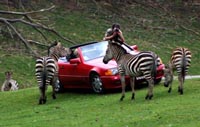Getting the most out of a workshop or field trip
by Pete Cross

Macro Workshop |

Safari Park |
We hope you look on these trips as an opportunity to not only take photos in various settings but to try out features on your cameras that we all have seen others use to advantage, but haven’t tried yet ourselves. Read over your camera’s instruction book and be sure to bring it with you. We will have several people with us who are willing to lend their expertise to help you figure out your instruction book and your camera, whether it be digital or film.
Here are some of the features that are found on many digital cameras today:
- manual focus, manual exposure
- reducing power of flash
- the 3 metering techniques: overall / averaging, center-weighted, and spot.
Have you tried these out? It would be to your advantage to read over how to use these features on your camera.
Be sure your camera’s battery is fully charged and your smart cards have been downloaded and re-formatted so you have plenty of room for many shots. One of the exercises will be to set your camera on multiple exposure and take a series of shots at whatever speed your camera permits, such as 3 frames per second. This can use up storage space!
Various types of rests for the camera will be available for your use: bean bags, tripods, monopods. I generally bring along two tripods and two monopods plus a small table top tripod, reflectors, external flash, etc. We need you all to bring whatever equipment you feel would be useful. It might be helpful to have an opaque cloth to throw over your head and camera in order to see the monitor screen clearly when in really bright sunlight.
If you plan to use low shooting angles requiring you to kneel or lie down, you might bring along knee pads or a gardening kneeling pad, or a piece of an old shower curtain in case the ground is wet to sit, lie, or kneel on! Hats and water bottles and an insulated food bag may add to your comfort.

